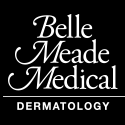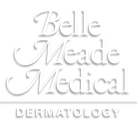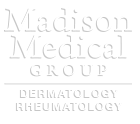Our Services
Belle Meade Medical Dermatology
Medical Screening
- Skin cancer screening – If you have a changing mole or skin lesion, especially if it’s asymmetric, has irregular borders, uneven color, a diameter greater than 5 mm, and it’s changing or growing (evolving), you should have a full body screening exam for skin cancers. *Routine skin examinations/screenings are performed daily by all the dermatology providers.
Medical Procedures
- Cryotherapy – liquid nitrogen destruction of warts and other benign growths (e.g. skin tags, seborrheic keratoses, etc.)
- Acne surgery –extractions of comedones and milia and injection of cystic lesions
- Chemical peels – for acne, melasma, photodamage – Belle Meade only
- Skin biopsy – for diagnosis of unknown skin conditions and cancers
- Skin tag removal – cryotherapy or snipping
- Blu light therapy – acne, photodamage and facial rejuvenation, and pre-cancers
- Sclerotherapy – treatment of spider veins on legs
- Laser treatment – acne, psoriasis, warts, seborrhea keratoses, spider veins and other vascular skin lesions, toe nail fungus, rosacea (adult acne), brown spots and aging spots, and facial rejuvenation –Belle Meade only
- Microdermabrasion – fine line wrinkles and acne
- Rejuvapen microneedling – facial rejuvenation, acne scars, stretch marks – Belle Meade only
- Surgical excision/removal – moles, skin cancers, cysts, and other benign lesions
- Botox – for excessive sweating (hyperhydrosis)
Diagnosis, Testing, and Treatment
We provide a wide variety of medical services that include diagnoses, testing, and treatment of a wide variety of pediatric and dermatologic conditions including but not limited to:
Dermatology
- Skin rashes
- Hair loss
- Skin cancers
- Acne – Acne is one of the most common skin conditions affecting all ages and ethnicities. It is most prevalent in teenagers and young adults, involves the face, chest and back, and consists of white heads, black heads, pustules, inflammatory papules and cysts which can lead to scarring. Treatment depends on the type of acne and severity. Many over the counter products containing benzoyl peroxide and salicylic acid may be adequate for mild acne. Moderate to severe scarring acne may require a combination of topical antibiotics, retinoids, oral antibiotics, oral contraceptives, and isotretinoin (more commonly known as Accutane).
- Rosacea – Rosacea is an adult inflammatory acne involving the mid face, nose, chin and forehead with pustules, papules, and redness/broken blood vessels. Some patients mainly have redness of the face which may fluctuate during the day and worsened by triggers such as hot spicy foods, red wine, heat, and sunlight. The redness of rosacea can be treated with laser and two new medications, Mirvaso and Rhofade, which help constrict the blood vessels in order to decrease the overall redness and flushing that may occur. The acne component is treated with oral low dose antibiotics such as doxycycline and topical medications such as metronidazole, Finacea, Soolantra, and sulfur/sulfacetamide creams.
- Psoriasis – Psoriasis may affect all ages but typically presents in the second to third decade of life. It is a chronic disease that can also present with arthritis. The scalp, elbows, knees, buttocks and nails are commonly affected with well defined thick red scaly plaques. Treatment is tailored to the areas and degree of involvement. Topical emollients, topical steroids and vitamin d creams, ultraviolet light, and systemic agents such as methotrexate, and the newer biologic agents such as Humira, Stellara, Cosyntex and Talz.
- Actinic keratoses – Actinic keratoses are precancerous lesions which have a low risk of developing into squamous cell carcinomas of the skin. These red crusted irregular patches are most common on chronically sun exposed areas like the face, ears, nose, neck and forearms. Although all lesions may not require treatment, some lesions are painful, irritated, and itchy and due to the potential risk of progression intervention with liquid nitrogen (burning or freezing individual lesions), topical chemotherapy creams, and photodynamic therapy (Blu light) may be warranted.
- Squamous cell carcinoma – Squamous cell carcinomas are the second most common skin cancer involving sun exposed skin most frequently on the head, neck, and arms. These cancers are usually red crusted scaly bumps and patches that may bleed easily and seem to not heal. Treatment can include topical chemotherapy creams, surgical removal, and in some cases radiation therapy. If left untreated, local destruction and deformity may occur in addition to spread of the cancer to the lymph nodes in high risk areas such as lips, ears, and hands.
- Basal Cell Carcinoma – The most common cancer with over 1 million cases reported a year, basal cell carcinomas present as pink to red pearly patches and bumps on the face, nose, ears, neck, arms and trunk. Although rarely do BCC’s spread, the cancer can lead to local destruction and deformity. Treatment consists of topical chemotherapy creams, surgical removal, and radiation in rare situations.
- Melanoma – Melanoma is the “black” skin cancer and the most deadly. Any changing mole is recommended to be evaluated to rule out the possibility of melanoma. The most common location for women is the lower leg and the back in men. Surgical removal is the treatment of choice with evaluation of lymph nodes in some cases to rule out early spread.
- Warts – Warts are caused by the human papilloma virus and are common in children involving the hands, fingers, feet, and toes most commonly. Treatment may be difficult if multiple lesions occur but most commonly methods of destruction are used such as burning or freezing the wart and sometimes surgical removal. Topical agents with salicylic acid and prescription imiquimod are also commonly used.
- Molluscum contagiosum – Molluscum contagiosum is a very common childhood viral condition presenting in 2-10 year olds typically with multiple small skin colored dome shaped papules. These “warts” may spontaneously resolve if left alone but in the case of multiple lesions treatment with topical imiquimod, liquid nitrogen, Cantharidin “beetle juice” or curettage may be warranted. There is currently no FDA approved treatment for molluscum. Chicken pox like scars may occur with or without treatment.
- Skin aging and rejuvenation
Aesthetics
- Obagi medical skin care products – utilized to restore healthy younger looking skin, blotchy pigmentation and melasma
- Microdermabrasion – to improve tone and texture of skin – Belle Meade only
- Rejuvapen (microneedling) – improves the overall appearance of fine lines and blotchy pigmentation, acne scarring, and stretch marks – Belle Meade only
- Botox, Dysport, Xeomin – utilized to relax frown lines and wrinkles
- Fillers – Juvederm products, Radiesse, Restylane are utilized to smooth away deep lines around the mouth, plump the lips, and lift the cheeks
- Candela V-beam pulsed dye laser and GentleMax Pro Laser – utilized to treat “age” spots, facial and leg spider veins, cherry/spider hemangiomas, port wine stains, rosacea, warts, scars, hair removal, psoriasis, and nail fungus – Belle Meade only


